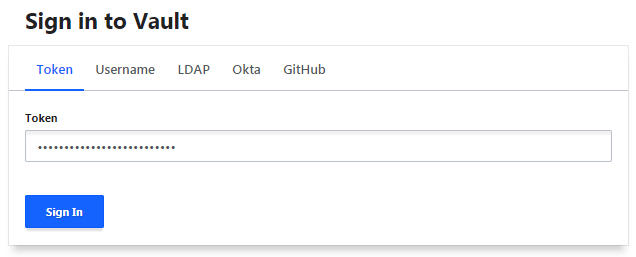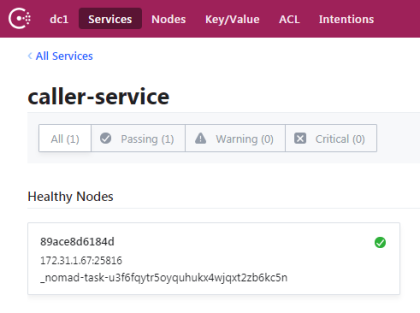Secure Spring Cloud Microservices With Vault and Nomad
Securing your microservices deployment is top-of-mind for any microservices-based project. We take a look at how to secure Spring Cloud microservices using Vault and Nomad.
Join the DZone community and get the full member experience.
Join For FreeOne of the significant topics related to microservices security is managing and protecting sensitive data like tokens, passwords or certificates used by your application. As a developer, you probably often implement software that connects with external databases, message brokers, or just other applications. How do you store the credentials used by your application? To be honest, most of the code I have seen in my life just stored sensitive data as plain text in the configuration files. Thanks to that, I was always able to retrieve the credentials to every database I needed at a given time just by looking at the application source code. Of course, we can always encrypt sensitive data, but if we are working with many microservices that have separated databases I may not be very comfortable with that solution.
Today I'm going to show you how to integrate you Spring Boot application with HashiCorp's Vault in order to store your sensitive data properly. The first good news is that you don't have to create any keys or certificates for encryption and decryption, because Vault will do it for you. In this article, in a few areas, I'll refer to my previous article about HashiCorp's solutions Deploying Spring Cloud Microservices on HashiCorp's Nomad. Now, as then, I also deploy my sample applications on Nomad to take advantage of built-in integration between those two very interesting HashiCorp tools. We will also use another HashiCorp solution for service discovery in inter-service communication, Consul. It's also worth mentioning that Spring Cloud provides a dedicated project for integration with Vault — Spring Cloud Vault.
Architecture
The sample presented in this article will consist of two applications deployed on HashiCorp Nomad callme-service and caller-service. Thecaller-service microservice is calling endpoints exposed by callme-service. Inter-service communication is performed using the name of the target application registered in the Consul server. The callme-service microservice will store the history of all interactions triggered by caller-service in the database. The credentials to the database are stored in Vault. Nomad is integrated with Vault and stores the root token, which is not visible to the applications. The architecture of the described solution is laid out in the following picture.

The current sample is pretty similar to the sample presented in my article Deploying Spring Cloud Microservices on Hashicorp's Nomad. It is also available in the same repository on GitHub sample-nomad-java-service, but in a different branch (vault). The current sample adds integration with PostgreSQL and the Vault server for managing credentials to a database.
1. Running Vault
We will run Vault inside a Docker container in development mode. The server in development mode does not require any further setup, it is ready to use just after startup. It provides in-memory encrypted storage and an unsecured (HTTP) connection, which is not a problem for demo purposes. We can override the default server IP address and listening port by setting the environment property VAULT_DEV_LISTEN_ADDRESS, but we won't do that. After startup, our instance of Vault is available on port 8200. We can use the admin web console, which I accessed under the address http://192.168.99.100:8200. The current version of Vault is 1.0.0.
$ docker run --cap-add=IPC_LOCK -d --name vault -p 8200:8200 vaultIt is possible to login using different methods, but the most suitable way for us is through a token. To do that we have to display container logs using the command docker logs vault, and then copy the Root Token as shown below.

Now you can log in to the Vault web console.

2. Integration With a Postgres Database
In Vault, we can create a Secret Engine that connects to other services and generates dynamic credentials on demand. Secret engines are available under path. There is the dedicated engine for the various databases, for example, PostgreSQL. Before activating such an engine we should run an instance of a Postgres database. This time we will also use a Docker container. It is possible to set login and password to the database using environment variables.
$ docker run -d --name postgres -p 5432:5432 -e POSTGRES_PASSWORD=postgres123456 -e POSTGRES_USER=postgres postgresAfter starting the database, we may proceed to the engine configuration in the Vault web console. First, let's create our first secret engine. We may choose between some different types of engines. The right choice, for now, is Databases.

You can apply a new configuration to Vault using the vault command or via the HTTP API. The Vault web console provides terminal for running CLI commands, but it could be problematic in some cases. For example, I have a problem with escaping strings in some SQL commands, and therefore I had to add it using the HTTP API. No matter which method you use, the next steps are the same. Following the Vault documentation, we first need to configure the plugin for our PostgreSQL database and then provide connection settings and credentials.
$ vault write database/config/postgres plugin_name=postgresql-database-plugin allowed_roles="default" connection_url="postgresql://{{username}}:{{password}}@192.168.99.100:5432?sslmode=disable" username="postgres" password="postgres123456"Alternatively, you can perform the same action using the HTTP API method. To authenticate against Vault, we need to add the header X-Vault-Token with a root token. I have disabled SSL for connection with Postgres by setting sslmode=disable. There is only one role allowed to use this plugin: default. Now, let's configure that role.
$ curl --header "X-Vault-Token: s.44GiacPqbV78fNbmoWK4mdYq" --request POST --data '{"plugin_name": "postgresql-database-plugin","allowed_roles": "default","connection_url": "postgresql://{{username}}:{{password}}@localhost:5432?sslmode=disable","username": "postgres","password": "postgres123456"}' http://192.168.99.100:8200/v1/database/config/postgresThe role can be created either with CLI or with the HTTP API. The name of the role should be the same as the name passed into the field allowed_roles in the previous step. We also have to set the target database name and SQL statement that creates the user with privileges.
$ vault write database/roles/default db_name=postgres creation_statements="CREATE ROLE \"{{name}}\" WITH LOGIN PASSWORD '{{password}}' VALID UNTIL '{{expiration}}';GRANT SELECT, UPDATE, INSERT ON ALL TABLES IN SCHEMA public TO \"{{name}}\";GRANT USAGE, SELECT ON ALL SEQUENCES IN SCHEMA public TO \"{{name}}\";" default_ttl="1h" max_ttl="24h"Alternatively, you can call the following HTTP API endpoint.
$ curl --header "X-Vault-Token: s.44GiacPqbV78fNbmoWK4mdYq" --request POST --data '{"db_name":"postgres", "creation_statements": ["CREATE ROLE \"{{name}}\" WITH LOGIN PASSWORD '{{password}}' VALID UNTIL '{{expiration}}';GRANT SELECT, UPDATE, INSERT ON ALL TABLES IN SCHEMA public TO \"{{name}}\";GRANT USAGE, SELECT ON ALL SEQUENCES IN SCHEMA public TO \"{{name}}\";"]}' http://192.168.99.100:8200/v1/database/roles/defaultAnd that's all. Now, we can test our configuration using a command with the role's name vault read database/creds/default as shown below. You can log in to the database using the returned credentials. By default, they are valid for one hour.

3. Enabling Spring Cloud Vault
We have successfully configured a secret engine that is responsible for creating a user on Postgres. Now, we can proceed to the development stage and integrate our application with Vault. Fortunately, there is a project, Spring Cloud Vault, which provides out-of-the-box integration with Vault database secret engines. The only thing we have to do is to include Spring Cloud Vault to our project and provide some configuration settings. Let's start with setting the Spring Cloud Release Train. We use the newest stable version Finchley.SR2.
<dependencyManagement>
<dependencies>
<dependency>
<groupId>org.springframework.cloud</groupId>
<artifactId>spring-cloud-dependencies</artifactId>
<version>Finchley.SR2</version>
<type>pom</type>
<scope>import</scope>
</dependency>
</dependencies>
</dependencyManagement>We have to include two dependencies to our pom.xml. The starter spring-cloud-starter-vault-config is responsible for loading the configuration from Vault and spring-cloud-vault-config-databases is responsible for integration with secret engines for databases.
<dependency>
<groupId>org.springframework.cloud</groupId>
<artifactId>spring-cloud-starter-vault-config</artifactId>
</dependency>
<dependency>
<groupId>org.springframework.cloud</groupId>
<artifactId>spring-cloud-vault-config-databases</artifactId>
</dependency>The sample application also connects to a Postgres database, so we will include the following dependencies.
<dependency>
<groupId>org.springframework.boot</groupId>
<artifactId>spring-boot-starter-data-jpa</artifactId>
</dependency>
<dependency>
<groupId>org.postgresql</groupId>
<artifactId>postgresql</artifactId>
<version>42.2.5</version>
</dependency>The only thing we have to do is to configure integration with Vault via Spring Cloud Vault. The following configuration settings should be placed in bootstrap.yml (no application.yml). Because we run our application on Nomad server, we use the port number dynamically set by Nomad available under environment property NOMAD_HOST_PORT_http and secret token from Vault available under environment property VAULT_TOKEN.
server:
port: ${NOMAD_HOST_PORT_http:8091}
spring:
application:
name: callme-service
cloud:
vault:
uri: http://192.168.99.100:8200
token: ${VAULT_TOKEN}
postgresql:
enabled: true
role: default
backend: database
datasource:
url: jdbc:postgresql://192.168.99.100:5432/postgresThe important part of the configuration visible above is under the property spring.cloud.vault.postgresql. Following the Spring Cloud documentation, "Username and password are stored in spring.datasource.username and spring.datasource.password so using Spring Boot will pick up the generated credentials for your DataSource without further configuration." Spring Cloud Vault is connecting with Vault and then using the role default (previously created on Vault) to generate new credentials for the database. Those credentials are injected into spring.datasource properties. Then, the application is connecting to a database using injected credentials. Everything works fine. Now, let's try to run our applications on Nomad.
4. Deploying Apps on Nomad
Before we start a Nomad node, we should also run Consul using its Docker container. Here's the Docker command that starts single node Consul instance.
$ docker run -d --name consul -p 8500:8500 consulAfter that, we can configure connection settings to Consul and Vault in the Nomad configuration. I have created the file nomad.conf. Nomad is authenticating itself against Vault using root token. Connection with Consul is not secured. Sometimes it is also required to set up a network interface name and total CPU on the machine for a Nomad client. Most clients are able to determine it automatically, but it does not work for me.
client {
network_interface = "Połączenie lokalne 4"
cpu_total_compute = 10400
}
consul {
address = "192.168.99.100:8500"
}
vault {
enabled = true
address = "http://192.168.99.100:8200"
token = "s.6jhQ1WdcYrxpZmpa0RNd0LMw"
}Let's run Nomad in development mode passing configuration file location.
$ nomad agent -dev -config=nomad.confIf everything works fine you should see a similar log on startup.

Once we have successfully started the Nomad agent and integrated it with Consul and Vault, we can proceed to application deployment. First, build the whole project with the mvn clean install command. The next step is to prepare Nomad's job descriptor file. For more details about the Nomad deployment process and its descriptor file, you can refer to my previous article about it (mentioned in the preface of this article). The descriptor file is available inside application's GitHub repo under path callme-service/job.nomad for callme-service, and caller-service/job.nomad for caller-service.
job "callme-service" {
datacenters = ["dc1"]
type = "service"
group "callme" {
count = 2
task "api" {
driver = "java"
config {
jar_path = "C:\\Users\\minkowp\\git\\sample-nomad-java-services-idea\\callme-service\\target\\callme-service-1.0.0-SNAPSHOT.jar"
jvm_options = ["-Xmx256m", "-Xms128m"]
}
resources {
cpu = 500# MHz
memory = 300# MB
network {
port "http" {}
}
}
service {
name = "callme-service"
port = "http"
}
vault {
policies = ["nomad"]
}
}
restart {
attempts = 1
}
}
}You will have to change the value of the jar_path property with your path of application binaries. Before applying this deployment to Nomad we will have to add some additional configuration on Vault. When adding integrations with Vault we have to pass the name of policies used for checking permissions. I set the policy with the name nomad, which now has to be created in Vault. Our application requires permission for reading the paths /secret/* and /database/* as shown below.

Finally, we can deploy our application callme-service on Nomad by executing the following command.
$ nomad job run job.nomadThe similar descriptor file is available for caller-service, so we can also deploy it. All the microservices have been registered in Consul as shown below.

Here is the list of registered instances of caller-service. As you can see in the picture below, it is available under port 25816.

You can also take a look at the Nomad jobs view.

Published at DZone with permission of Piotr Mińkowski, DZone MVB. See the original article here.
Opinions expressed by DZone contributors are their own.

Comments